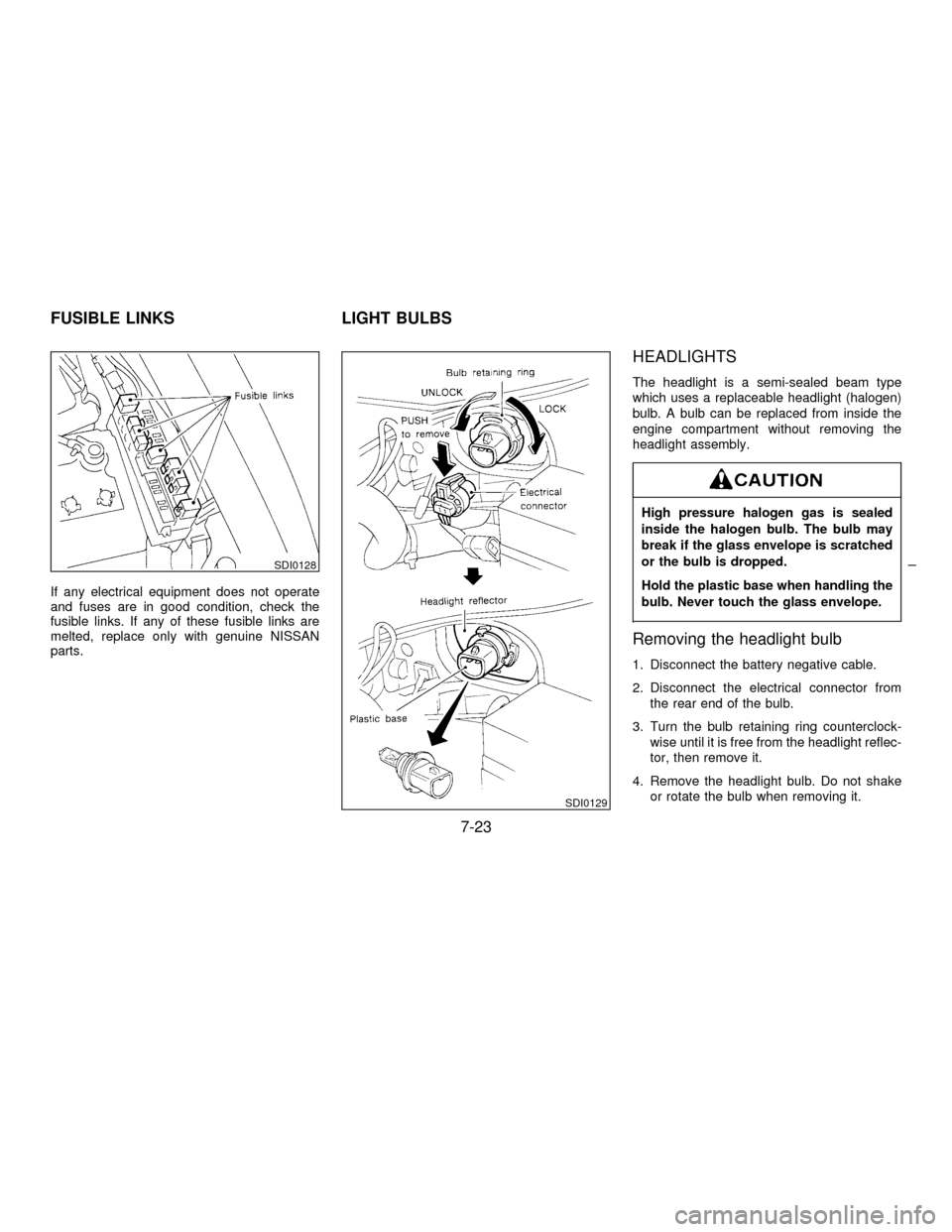Page 42 of 215
Trunk lid release operation
Type A
The trunk lid release lever is located on the
outside of the driver's seat. To open the trunk
lid, pull up the trunk lid release lever. To close,push the trunk lid down securely.
Type B
The trunk lid release button is located under
the driver's arm rest.
To open the trunk lid, push the release button.
To close, push the trunk lid down securely.
Key operation
To open the trunk lid, turn the key clockwise.
To close, lower and push the trunk lid down
securely.
Do not drive with the trunk lid open. This
could allow dangerous exhaust gases to
be drawn into the vehicle. See ªExhaust
Gasº in the ªStarting and drivingº
section.SPA0093
SPA0094
TRUNK LID LOCK
2-9
Z01.2.1/A32-DX
Page 43 of 215
OPENER CANCEL LEVER FOR
TRUNK LID
When the lever is in the ªCANCELº position,
the trunk lid cannot be opened with the trunk
lid release lever or handle. It can be opened
only with the key.
Opener lever
Type A
To open the fuel filler lid, pull the opener lever.
To lock, close the fuel filler lid securely.
Type B
To open the fuel filler lid, push the opener lever
down. To lock, close the fuel filler lid securely.
FUEL FILLER CAP
The fuel filler cap is a screw-on ratcheting
type. Tighten the cap clockwise until ratcheting
clicks are heard.
IGasoline is extremely flammable and
highly explosive under certain condi-
tions. You could be burned or seri-
ously injured if it is misused or mis-
handled. Always stop the engine and
do not smoke or allow open flames or
SPA0095SPA0096SPA0119
FUEL FILLER LID LOCK
2-10
Z01.2.1/A32-DX
Page 156 of 215

Type B
To check the fluid level, use your finger to plug
the center hole of the cap (as shown above),
then remove it from the tank. If there is no fluid
in the tube, add fluid. Add a washer solvent to
the water for better cleaning. In the winter
season, add a windshield washer anti-freeze.
Follow the manufacturer's instructions for the
mixture ratio.
Anti-freeze is poisonous and should be
stored carefully in marked containers
out of the reach of children.
Do not substitute engine anti-freeze
coolant for window washer solution.
This may result in damage to the paint.
IKeep the battery surface clean and dry. Any
corrosion should be washed off with a
solution of baking soda and water.
IMake certain the terminal connections are
clean and securely tightened.
IIf the vehicle is not to be used for 30 days or
longer, disconnect the ªÐº negative battery
terminal cable to prevent discharge.
IDo not expose the battery to flames
or electrical sparks. Hydrogen gas
generated by battery action is explo-
sive. Do not allow battery fluid to
contact your skin, eyes, fabrics, or
painted surfaces. After touching a
battery or battery cap, do not touch or
rub your eyes. Thoroughly wash your
hands. If the acid contacts your eyes,
skin or clothing, immediately flush
with water for at least 15 minutes and
seek medical attention.
IWhen working on or near a battery,
always wear suitable eye protection
and remove all jewelry.
IKeep the battery out of the reach of
SDI0497
BATTERY
7-13
Z01.2.1/A32-DX
Page 166 of 215

If any electrical equipment does not operate
and fuses are in good condition, check the
fusible links. If any of these fusible links are
melted, replace only with genuine NISSAN
parts.
HEADLIGHTS
The headlight is a semi-sealed beam type
which uses a replaceable headlight (halogen)
bulb. A bulb can be replaced from inside the
engine compartment without removing the
headlight assembly.
High pressure halogen gas is sealed
inside the halogen bulb. The bulb may
break if the glass envelope is scratched
or the bulb is dropped.
Hold the plastic base when handling the
bulb. Never touch the glass envelope.
Removing the headlight bulb
1. Disconnect the battery negative cable.
2. Disconnect the electrical connector from
the rear end of the bulb.
3. Turn the bulb retaining ring counterclock-
wise until it is free from the headlight reflec-
tor, then remove it.
4. Remove the headlight bulb. Do not shake
or rotate the bulb when removing it.
SDI0128
SDI0129
FUSIBLE LINKS LIGHT BULBS
7-23
Z01.2.1/A32-DX
Page 189 of 215

The following are approximate capacities. The actual refill capacities may be a little
different. When refilling, follow the procedure instructed in the ªDo-it-yourself operationsº
section to determine the proper refill capacity.
Capacity (Approximate)
Recommended
specifications US
measureImp
measureLiter
Fuel 18-1/2 gal 15-3/8 gal 70Unleaded gasoline with an octane rating
of at least 91 AKI (RON 96)
Engine oil (Refill)
With oil filter 4-1/4 qt 3-1/2 qt 4.0IAPI SG or SH and Energy Conserving
II*1, *2
IAPI Certification Mark*1, *2 Without oil filter 3-7/8 qt 3-1/4 qt 3.7
Cooling system
With reservoir 9 qt 7-1/2 qt 8.5
Anti-freeze coolant
(Ethylene glycol base)
Reservoir 7/8 qt 3/4 qt 0.8
Manual transmission gear oilÐ Ð Ð API GL-4*2
Automatic transmission fluid
Refill to the proper oil level according
to the instructions in the ªDo-it-
yourself operationsº section.Nissan Matic ªDº (Continental U.S. and
Alaska) or Genuine Nissan Automatic
Transmission Fluid (Canada).*3
Power steering fluidType DEXRON
TMIIE, DEXRONTMIII or
equivalent
Brake and clutch fluidGenuine Nissan Brake Fluid or equiva-
lent*4
DOT 3 (US FMVSS No. 116)
Multi-purpose greaseÐ Ð Ð NLGI No. 2 (Lithium soap base)
Air conditioning system refrigerantÐ Ð Ð HFC-134a (R-134a)
Air conditioning system lubricants Ð Ð ÐNissan A/C System Oil
Type S or exact equivalent
*1: For further details, see ªEngine oil and oil filter recommendationº.
*2: For further details, see ªRecommended SAE viscosity numberº.
*3: Dexron
TMIII/MerconTMor equivalent may also be used. Outside the continental United States and Alaska contact a NISSAN dealer for
more information regarding suitable fluids, including recommended brand(s) of DexronTMIII/MerconTMor DexronTMIIE/MerconTMAutomatic Transmission Fluid.
*4: For more information regarding suitable fluids, contact a NISSAN dealer.
FUEL RECOMMENDATION
Unleaded premium gasoline with an octane
rating of at least 91 AKI (Anti-Knock Index)
number (Research octane number 96)
If unleaded premium gasoline is not avail-
able, unleaded regular gasoline with an
octane rating of at least 87 AKI (Research
octane number 91) can be used.
However, for maximum vehicle perfor-
mance, the use of unleaded premium gaso-
line is recommended.
Using a fuel other than that specified
could adversely affect the emission con-
trol devices and systems, and could
also affect the warranty coverage.
Under no circumstances should a
leaded gasoline be used, since this will
damage the three-way catalyst.
Reformulated gasoline
Some fuel suppliers are now producing refor-
mulated gasolines. These gasolines are spe-
cially designed to reduce vehicle emissions.
CAPACITIES AND
RECOMMENDED
FUEL/LUBRICANTS
9-2
Z01.2.1/A32-DX
Page 195 of 215
Model VQ30DE
Type Gasoline, 4-cycle
Cylinder arrangement 6-cylinder, V-slanted at 60É
Bore x Stroke in (mm) 3.66 x 2.886 (93.0 x 73.3)
Displacement cu in (cm
3) 182.33 (2,988)
Firing order 1-2-3-4-5-6*
Idle speed rpm
See the ªEmission Control Labelº
on the underside of the hood. Ignition timing (B.T.D.C.) degree/rpm
CO percentage at idle speed [No air] %
Spark plugStandard PFR5G-11
Service option PFR4G-11, PFR6G-11
Spark plug gap in (mm) Ð
Camshaft operation Timing chain
Alternator belt size
Width x Length in (mm) 0.8409 x 43.11 (21.36 x 1,095)
The spark ignition system of this vehicle
meets all requirements of the Canadian
Interference-Causing Equipment Regula-
tions.
TI1009-A
ENGINE
9-8
Z01.2.1/A32-DX